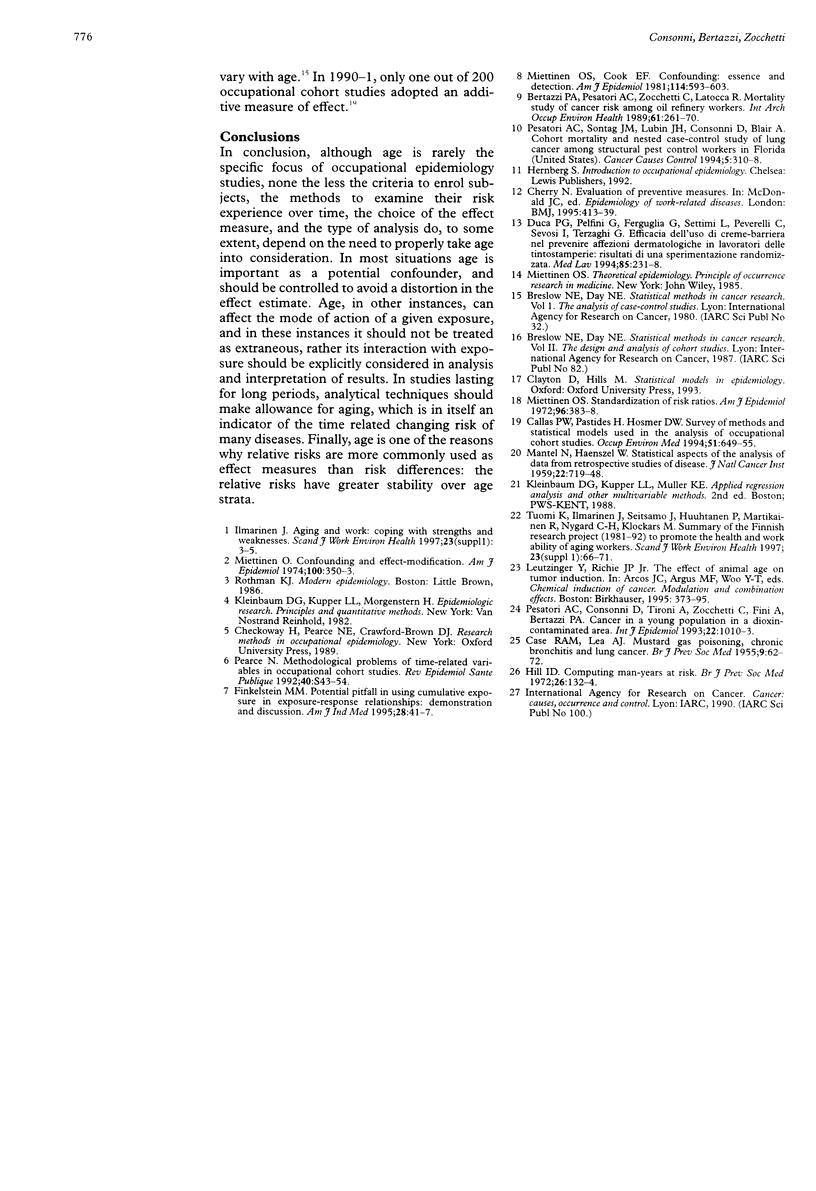Abstract
In occupational epidemiology, the need to consider the age factor properly influences the choice of study design and analytical techniques. In most studies, age is viewed as a potential confounder. Age is strongly associated with end points of interest in occupational epidemiology (diseases, physiological characteristics, doses of xenobiotics, etc), but to measure age as a confounder it must be associated with the exposure under study. When the exposure of interest is time related-for example, duration of employment, time since first exposure, cumulative exposure-a strong intrinsic association with age can be anticipated, and age will behave as a (usually strong) confounder. When occupational exposures without a direct relation with age-for example, job, department, type of exposure-are evaluated, the degree and direction of confounding bias cannot be anticipated. Control of the confounding effect of age can be accomplished in the design phase of a study by way of randomisation, restriction, and matching. Randomisation is seldom viable in occupational settings. Restriction is rarely used in the case of age. Matching is often used in a case-control study as a method to increase the study efficiency, but it must be followed by proper matched or stratified analysis. Options for age adjustment in the analysis phase involve stratification and regression methods. In longitudinal studies the modified life table analysis is used to take into account the fact that subjects cross categories of age as the study proceeds. Stability of relative measures of effect over age strata favoured the greater use of relative risks than risk differences. In the presence of effect modification the influence of age should not be eliminated; its interaction with exposure should be explicitly considered.
Full text
PDF




Selected References
These references are in PubMed. This may not be the complete list of references from this article.
- Bertazzi P. A., Pesatori A. C., Zocchetti C., Latocca R. Mortality study of cancer risk among oil refinery workers. Int Arch Occup Environ Health. 1989;61(4):261–270. doi: 10.1007/BF00381424. [DOI] [PubMed] [Google Scholar]
- CASE R. A., LEA A. J. Mustard gas poisoning, chronic bronchitis, and lung cancer; an investigation into the possibility that poisoning by mustard gas in the 1914-18 war might be a factor in the production of neoplasia. Br J Prev Soc Med. 1955 Apr;9(2):62–72. doi: 10.1136/jech.9.2.62. [DOI] [PMC free article] [PubMed] [Google Scholar]
- Callas P. W., Pastides H., Hosmer D. W. Survey of methods and statistical models used in the analysis of occupational cohort studies. Occup Environ Med. 1994 Oct;51(10):649–655. doi: 10.1136/oem.51.10.649. [DOI] [PMC free article] [PubMed] [Google Scholar]
- Duca P. G., Pelfini G., Ferguglia G., Settimi L., Peverelli C., Sevosi I., Terzaghi G. Efficacia dell'uso di creme-barriera nel prevenire affezioni dermatologiche in lavoratori delle tintostamperie: risultati di una sperimentazione randomizzata. Med Lav. 1994 May-Jun;85(3):231–238. [PubMed] [Google Scholar]
- Finkelstein M. M. Potential pitfall in using cumulative exposure in exposure-response relationships: demonstration and discussion. Am J Ind Med. 1995 Jul;28(1):41–47. doi: 10.1002/ajim.4700280104. [DOI] [PubMed] [Google Scholar]
- Hill I. D. Computing man years at risk. Br J Prev Soc Med. 1972 May;26(2):132–134. doi: 10.1136/jech.26.2.132. [DOI] [PMC free article] [PubMed] [Google Scholar]
- MANTEL N., HAENSZEL W. Statistical aspects of the analysis of data from retrospective studies of disease. J Natl Cancer Inst. 1959 Apr;22(4):719–748. [PubMed] [Google Scholar]
- Miettinen O. S., Cook E. F. Confounding: essence and detection. Am J Epidemiol. 1981 Oct;114(4):593–603. doi: 10.1093/oxfordjournals.aje.a113225. [DOI] [PubMed] [Google Scholar]
- Miettinen O. S. Standardization of risk ratios. Am J Epidemiol. 1972 Dec;96(6):383–388. doi: 10.1093/oxfordjournals.aje.a121470. [DOI] [PubMed] [Google Scholar]
- Miettinen O. Confounding and effect-modification. Am J Epidemiol. 1974 Nov;100(5):350–353. doi: 10.1093/oxfordjournals.aje.a112044. [DOI] [PubMed] [Google Scholar]
- Pearce N. Methodological problems of time-related variables in occupational cohort studies. Rev Epidemiol Sante Publique. 1992;40 (Suppl 1):S43–S54. [PubMed] [Google Scholar]
- Pesatori A. C., Consonni D., Tironi A., Zocchetti C., Fini A., Bertazzi P. A. Cancer in a young population in a dioxin-contaminated area. Int J Epidemiol. 1993 Dec;22(6):1010–1013. doi: 10.1093/ije/22.6.1010. [DOI] [PubMed] [Google Scholar]
- Pesatori A. C., Sontag J. M., Lubin J. H., Consonni D., Blair A. Cohort mortality and nested case-control study of lung cancer among structural pest control workers in Florida (United States). Cancer Causes Control. 1994 Jul;5(4):310–318. doi: 10.1007/BF01804981. [DOI] [PubMed] [Google Scholar]
- Tuomi K., Ilmarinen J., Seitsamo J., Huuhtanen P., Martikainen R., Nygård C. H., Klockars M. Summary of the Finnish research project (1981-1992) to promote the health and work ability of aging workers. Scand J Work Environ Health. 1997;23 (Suppl 1):66–71. [PubMed] [Google Scholar]


